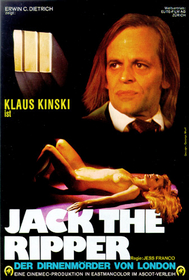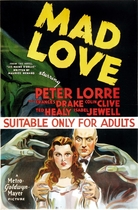Our editor-in-chief Nate Yapp is proud to have contributed to the new book Hidden Horror: A Celebration of 101 Underrated and Overlooked Fright Flicks, edited by Aaron Christensen. Another contributors include Anthony Timpone, B.J. Colangelo, Dave Alexander, Classic-Horror.com's own Robert C. Ring and John W. Bowen. Pick up a copy today from Amazon.com!
Jack the Ripper (1976)
Many attempts have been made to dramatize the tale of Jack the Ripper, but Jesus Franco's 1976 effort into the subject proves to be one of the best. Our killer is given a sense of duality and warped motivations that surpass those provided to him in other treatments and some of the camera work and direction is impressively well planned and executed. However - though it may be one of the better attempts at the subject matter in general - certain internal issues, like limp acting, steal some vital impact from the film and manage to hold it back from being a full-fledged classic.
The film mainly concerns one Dr. Orloff - a trusted member of society and respected physician - who finds himself driven by his own lust and psychosis to brutally murder local prostitutes under the cover of night. As Orloff's bloody rampage continues ( and word of 'Jack the Ripper' begins to spread in the papers and on the streets), the police realize they have a serial murderer on their hands but seem virtually powerless to stop him. In spite of the efforts of Scotland Yard's best men, the only lead they have is a blind "witness" who is openly superstitious and often references the supernatural. In a desperate effort to bait and capture the Ripper, the lead detective's girlfriend, Cynthia, volunteers to pose as one of the street-walkers and gets in over her head...
The best aspect of the film by far is Klaus Kinski's portrayal of Dr. Orloff/Jack the Ripper. His mild-mannered and generous daytime persona as town doctor is a well-played counterpoint to the wildly perverse, homicidal madman that he becomes at night. Everything from Kinski's speech, demeanor and even breathing change drastically when he shifts from one personality into the other. There are even some occasions where he slips between both personalities and a few degrees in between with relative ease - all within the same scene.
One such shift is seen about an hour into the film, where Dr.Orloff has taken one of his victims-to-be deep into the woods in his carriage. At first, his demeanor is polite and timid as he convinces her to come with him, but, once they have reached their isolated destination he becomes distant and strange. The prostitute tries to engage him in conversation and begins coming onto him, but this only triggers the madman within. In this scenario, most actors would likely take the quick-change approach and lunge directly into action after a few quiet moments for a cheap scare. Instead, Kinski plays this build-up in tension as an internal struggle, shown only through pained and sporadic breathing and subtle changes in expression. Clearly, he is fighting a losing battle against his inner demons which makes us worry about a prostitute we have no reason to care for whatsoever, all the while adding an amount of emotional depth to the killer himself that makes him much more than a just another maniac with a knife. This simple, yet expertly played twist on the character raises a well written scene to a new dramatic height, which is no easy feat to accomplish for any actor in any genre. Somehow, Kinski makes it look effortless. Though I had seen him in several other films ( usually as a supporting player ), this was the first time I was really struck with his abilty as an actor. This was Kinski's fourth and last collaboration with Jesus Franco and he certainly made it count. This is a highly recommended film for fans of Kinski's work.
Another aspect worth mention is the beautiful cinematography. Though the film is set in Victorian London, it was actually filmed in and around Zurich, Switzerland. Taking what could be a terrible disadvantage to most filmmakers, Jesus Franco walks a very thin line between stark reality and fairy tale beauty with his shots. Realism is not the objective here, but to stage ugliness against beauty in a never-never land of sorts that is occasionally sprinkled with bloody violence, sexual perversity and, of course, gratuitous nudity. For example, when Orloff commits a graphically heinous crime in a foggy, beautifully backlit forest, it seems as out place and unthinkable as if it were happening in a children's movie. As it plays out, the sheer beauty of the scene is inviting and almost awe-inspiring, yet the act of murder at it's center is played out with such unflinching horror that it makes you actually feel the awfulness of the crime you are witnessing. In stark contrast, the environments in which we witness the police at work are filmed and lit in a more conventional way, making those scenes feel more "real" than the murder scenes. Visually, Franco has provided us with two worlds here - the real world and the fantasy world. While every other character in the story is firmly planted in the real world, Orloff comes and goes between our world and his own fantsy world. It is a unique and interesting effect that is put to good use throughout the picture.
The violence is pretty extreme and heavier on gore than I had expected going in. We are treated to many severings and graphic slashings from the opening scene until the final minutes of the last act. Murders come quickly and ferociously, lending them a more realistic feel and making them seem even more shocking against the fairy tale style surroundings mentioned above. The murders rarely hold back and we see various parts of the female anatomy attacked in graphic detail. The Ripper does not merely aim to kill his victims - he destroys them. The calculated viciousness of the Ripper's attacks make him a truly cold hearted and fearsome villain.
There is one key scene that mingles all three elements mentioned above - Kinski's masterful acting, great cinematography and brutally perverse violence. We are given a very basic set-up, torn from the pages of homicidal madman 101 - a girl is alone in the woods with our titular knife-wielding maniac and she is gonna die in a bad, bad way. Instead of playing the scene as a straight bloodbath, we are returned to the surreal world of fantasy. The combination of eerie backlighting, hanging fog and a viewpoint that uses the trees to literally frame the scene almost gives you the feeling that you are looking at a beautiful painting of a lush, mysterious forest. In spite of this pleasant surrounding, at the center of the frame we have what looks like a man making passionate love to a woman, which tweaks our 'beautiful' view into a bizarre discomfort - like we are watching something we shouldn't be seeing. Amongst these beautifully staged long-shots, we are given sporadic close-ups of what is really going on between those shadowy figures as we see the Ripper's knife doing it's dirty work in gruesome detail. As the Ripper continues to cut and slash pieces of her away, he gradually builds into a frenzy resembling sexual climax as her life finally slips away. Moments like these are what make the film work by drawing you into the action as it unfolds with beauty, then surprising you with unbridled horror.
Unfortunately, there are a few performances by supporting members of the cast that drag the film to a near standstill. Most of the supporting cast is disappointing, including a wise-cracking cop who does nothing but drop unfunny one-liners and make silly faces in the backgound. You can tell he is trying to be funny in a quirky way, but he never comes close to achieving his goal and seems entirely out of place in this picture. The secondary lead - Andreas Mannkopff's Inspector Selby - shows not one hint of emotion, despite the fact that there are secondary plots revolving around his troubled relationship with the girl he loves, the professional pressures of being in charge of a high profile case and impending civil unrest due to his inabilty to catch the Ripper. With all of these factors, it is downright frustrating and irritating to watch him sleepwalking through his role. He comes across as a careless jerk instead of our sympathetic hero. I suspect this is one of the reasons, if not the main reason, that the film does fall short in spots - our 'hero' is completely disinteresting (and seems disinterested himself), which leaves us with no one to identify with and makes the scenes that attempt to flesh out his character seem wasted and pointless. Likewise, when his girlfriend puts herself on the line to help him in the third act, it seems a foolish and unwarranted move that we, as an audience, can't connect with. Why would she risk her life for this lifeless shell of a man? While the poor acting doesn't totally ruin the film, it certainly takes it down a level from what it could have been and probably was on paper. If not for the wise choice of leaving much of the weight of the story on the shoulders of Kinski's Orloff, the supporting cast could easily have sunk this movie far below the line of mediocrity.
Overall, this is a solid effort. The film manages to take a simple killer by night tale and elevate it to a truly disturbing experience with interesting visuals and a compelling central character, which certainly makes it worth seeing at least once. For those who want a classy, facts-based detailing of the Whitechapel murders, this is not the film for you. However, if you are a fan of Franco or Kinski - or perhaps just like a good, old fashioned Victorian England-set exploitation movie filled with gore, nudity and disturbing concepts - this should prove a worthwhile treat.









As far as Jack the Ripper
As far as Jack the Ripper goes, this movie is historically inaccurate but surprisingly well made for a Franco movie. However, I feel the movie could have benefited from some more edits as most of the gore sequences are just plain nasty and inept.